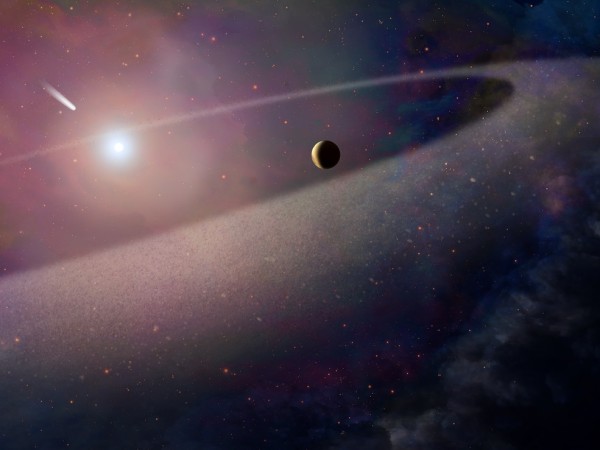By Ana Verayo, | February 12, 2017

This artist's concept shows a massive, comet-like object falling toward a white dwarf. (NASA, ESA, and Z. Levy (STScI))
NASA scientists have revealed that the basic building blocks of life can also be found in a distant white dwarf star 200 light years away from Earth. This latest discovery is courtesy of NASA's Hubble Space Telescope.
White dwarf stars are remnants of red dwarf stars that are also extremely dense. When stars burn and exhaust their remaining stellar fuel or nuclear fuel, they collapse into this dense mass similar to the mass of our sun.
Like Us on Facebook
This particular white dwarf is known as WD 1425+540 and is located in the Bootes constellation, as observed by the Hubble Space Telescope. It contains crucial elements like oxygen, hydrogen, carbon and nitrogen that are also known as the basic components of life.
In this new study, scientists from the European Southern Observatory and the University of California, Los Angeles studied the elements within this white dwarf star, which are also similar to our very own solar system. According to the co-author of the study, Benjamin Zuckerman of UCLA, this study presents new evidence that there is also a planetary system in this white dwarf, which contains material considered as the building blocks for life.
Also, this system shares similar characteristics with our solar system, including others in the Milky Way galaxy as well. This also suggests that these conditions are also common around the universe that can lead to life in distant galaxies.
During the early formation stages of Earth, water, carbon, and nitrogen bombarded the planet in the form of asteroids and comets from other parts of the solar system. These introduced ideal conditions that would help Earth develop microbial life.
Now, scientists suggest that this white dwarf star also possesses some orbiting planets. However, one of its small planets had its orbit disturbed by a major planet also orbiting this system. Due to extremely powerful gravitational forces, this small planet slammed into the white dwarf in a violent collision, as debris and gas shattered surrounding the star.
Zuckerman added that these remnants were pulled in by the white dwarf, forming a planetary disk similar to Saturn's rings. This colossal event's debris also brought about these building blocks of life elements.
ESO's Siyi Xu concludes that this occurred just 100,000 years ago making this study the first to detect nitrogen within planetary debris surrounding a white dwarf. Nitrogen is crucial for life, and this galactic object is very rich in nitrogen, making this the most nitrogen-rich within the solar system.
This new study was published in the Astrophysical Journal Letters.
-
Use of Coronavirus Pandemic Drones Raises Privacy Concerns: Drones Spread Fear, Local Officials Say

-
Coronavirus Hampers The Delivery Of Lockheed Martin F-35 Stealth Fighters For 2020

-
Instagram Speeds Up Plans to Add Account Memorialization Feature Due to COVID-19 Deaths

-
NASA: Perseverance Plans to Bring 'Mars Rock' to Earth in 2031

-
600 Dead And 3,000 In The Hospital as Iranians Believed Drinking High-Concentrations of Alcohol Can Cure The Coronavirus

-
600 Dead And 3,000 In The Hospital as Iranians Believed Drinking High-Concentrations of Alcohol Can Cure The Coronavirus

-
COVID-19: Doctors, Nurses Use Virtual Reality to Learn New Skills in Treating Coronavirus Patients







